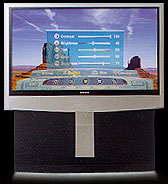Perhaps
the earliest notion of High Definition Television known to mankind dates
back to the year 1934, when RCA first introduced the term in its annual
report to describe the future of television broadcasting and how it would
affect consumer's lives. David Sarnoff, president of RCA in 1926, stated
the following with respect to the role television would have on peole's
lives and culture in general:
"The whole
country will join in every national procession. The backwoodsman will be
able to follow the play of expression on the face of a leading artist.
Mothers will attend child welfare classes in their own homes. Workers may
go to night school in the same way. A scientist can demonstrate his latest
discoveries to those in his profession."
It is known
that The Pentagon first began using high definition technology during the
1950’s in military spy planes and spy satellites. Unfotunately, throughout
the 1960's, the United States lost the television manufacturing industry
to Asian countries like Japan, so the interest in HDTV drops. The Japanese
continued working on such technology and they introduced the first HDTV
in 1970. Although it was still an analog transmision, their new system
called MUSE, required more bandwith than then current NTSC.
Japan’s HDTV
under the MUSE system offered:
 Up to 1125 lines of resolution versus 600 lines of regular television.
Up to 1125 lines of resolution versus 600 lines of regular television.
 Each frame is scanned at 1/60th of a second versus 1/30th of a second
Each frame is scanned at 1/60th of a second versus 1/30th of a second
 Wider and larger viewing screen that gives a 30 degree angle versus a 10
degree angle with the regular system.
Wider and larger viewing screen that gives a 30 degree angle versus a 10
degree angle with the regular system.
 Viewing distance is less so viewers do not notice scanning lines and will
not experience eye fatigue.
Viewing distance is less so viewers do not notice scanning lines and will
not experience eye fatigue.
 Multiple sound channels
Multiple sound channels
 After the Japanese
development of HDTV, the US government realizes the importance of not missing
this new market. High Definition Television
created such a sentiment of delight, that some politicians even argued
how HDTV could solve the balance of trade deficit and the national debt
problem. Hence, in 1988, around 23 advanced television system proposals
had been submitted to the FCC Advisory Committee. All but one of the systems
used analog technology. Clearly, the one using digital technology won.
Although the proposed system was fairly competent with the Japanese standard,
in 1993, the FCC decides to form an alliance to create a new global digital
standard for HDTV in order to fix some of the technological shortcomings
of the proposed system. The formed alliance was known as The Grand Alliance.
After the Japanese
development of HDTV, the US government realizes the importance of not missing
this new market. High Definition Television
created such a sentiment of delight, that some politicians even argued
how HDTV could solve the balance of trade deficit and the national debt
problem. Hence, in 1988, around 23 advanced television system proposals
had been submitted to the FCC Advisory Committee. All but one of the systems
used analog technology. Clearly, the one using digital technology won.
Although the proposed system was fairly competent with the Japanese standard,
in 1993, the FCC decides to form an alliance to create a new global digital
standard for HDTV in order to fix some of the technological shortcomings
of the proposed system. The formed alliance was known as The Grand Alliance.
AT&T
Corp.
MIT
Phillips
Corp.
The David
Sarnoff Research Center and
Thomson
Consumer Electronics
Zenith
Corp.
If the Grand
Alliance could come up with a new system, the government would give away
the new spectrum required for HDTV in exchange for the current one. Hence,
the new ATS (Advanced Television System) was created and it was decided
by the US government that that would be the system to adopt nationwide
to transmit High Definition Television.
“True
HDTV has five times the visual detail, ten times the color information
and more than twice the horizontal and vertical resolution of NTSC television.
Moreover, the picture is substantially brighter, the aspect ratio is more
than a third larger and the sound quality is equivalent to that of compact
discs.”
Corey
Carbonara
New
Video Technologies Project
Director
Baylor
University
The Congressional
Budget Office (CBO) estimates that auctions of licenses to use the radio
spectrum conducted by the Federal Communications Commission (FCC) from
1994 through 1998 will yield $27.0 billion in receipts to the Federal Treasury.
